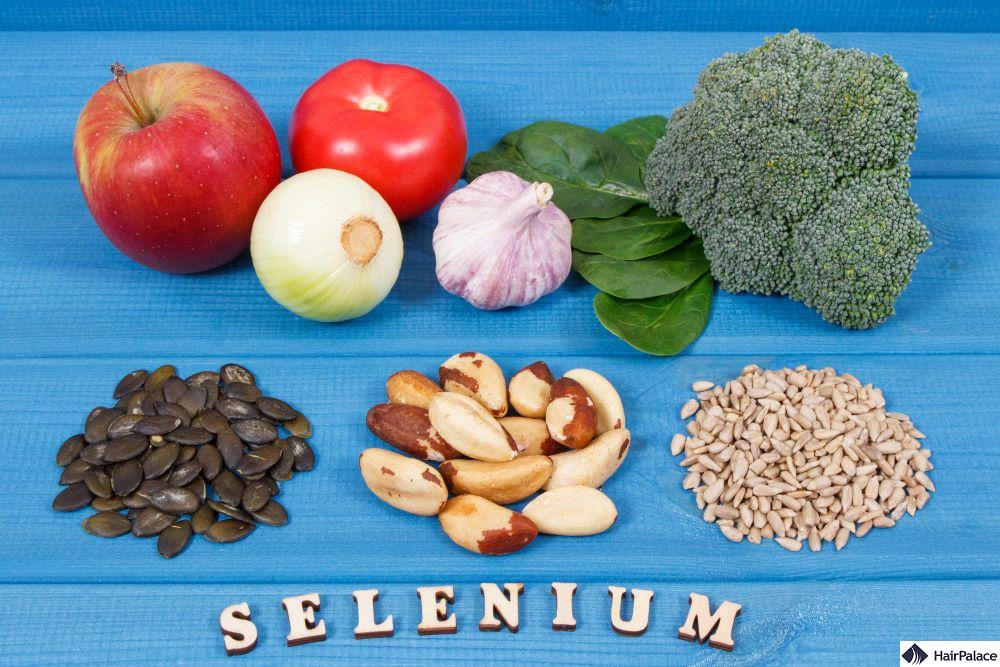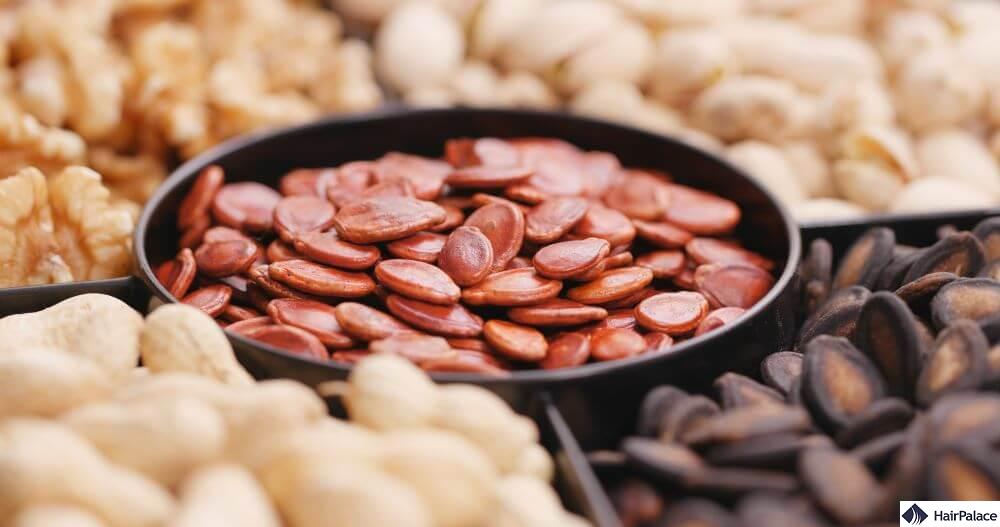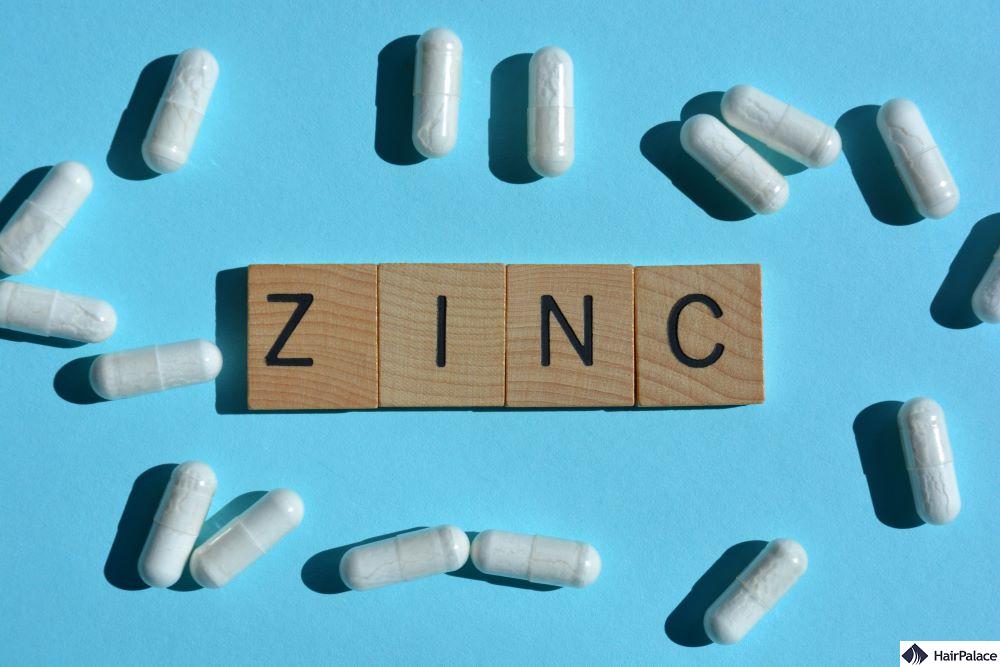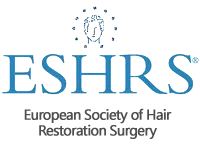Selenium for hair loss: How effective is it?

Selenium, a trace mineral essential for many bodily functions, has gained attention for its potential ability to promote hair growth.
While deficiencies can lead to selenium hair loss and other health problems, excess intake may also cause hair shedding and toxicity.
But does selenium help hair growth?
This article explores the science behind selenium’s impact on hair, its benefits and risks, and the relationship between selenium and hair loss.
- What is selenium?
- Is selenium good for hair?
- Can too much selenium cause hair loss?
- Some of the best selenium-rich foods
- Selenium side effects
- Alternatives to selenium for hair growth
What is selenium?
Selenium is a vital trace mineral that the human body needs in small amounts for optimal health.
The body incorporates it into selenoproteins, important enzymes with antioxidant properties that protect cells by neutralising free radicals.
Selenium plays critical roles in several biological processes, including thyroid hormone production, immune function, reproductive health, and DNA.
For example, the thyroid gland contains the highest concentrations of selenium in the body, where selenium-dependent enzymes play a crucial role in regulating thyroid function.
In summary, selenium is a micronutrient vital for maintaining many aspects of health at the cellular level.
Is selenium good for hair?

Adequate selenium for hair supports healthy growth, primarily through its role in antioxidant defence and thyroid regulation.
Hair follicles are metabolically active and prone to oxidative stress; selenium is a cofactor for glutathione peroxidase, an antioxidant enzyme that helps protect hair follicle cells from free radical damage.
Scientific studies indicate that selenium is involved in the generation of new hair: newly forming hair shafts incorporate selenium from the blood supply.
Selenium deficiency can contribute to hair loss and hair depigmentation.
These findings suggest that selenium when properly balanced, is beneficial for hair follicle function.
It supports hair growth cycles and the structural integrity of hair fibres by reducing oxidative damage and aiding the formation of healthy hair shaft proteins.
It’s important to emphasise that selenium benefits for hair only manifest up to an optimal level.
Maintaining adequate selenium status helps prevent hair problems associated with deficiency.
However, there is little evidence that supplementation beyond nutritional needs will result in selenium hair growth in people who are not deficient.
Can too much selenium cause hair loss?

Excessive selenium intake can cause hair loss, among other symptoms. Chronic overconsumption of selenium leads to a toxicity syndrome known as selenosis.
One of the hallmark signs of selenosis is alopecia (hair loss), often in the form of telogen effluvium (diffuse shedding of hair).
Hair loss and brittle nails are early warning signs of selenium overdose.
For example, the U.S. National Institutes of Health notes that getting too much selenium can cause hair loss, brittle nails, garlic-like breath odour, and a metallic taste, along with other symptoms.
How much selenium for hair should you take?
The Recommended Dietary Allowance (RDA) for selenium in adults is 55 micrograms (mcg) per day for both men and women.
This amount sufficiently meets the needs of 97–98% of healthy individuals and supports all the vital functions of selenium hair benefits in the body.
The tolerable upper intake level (UL) for selenium in adults is about 400 μg per day, and intakes beyond this threshold increase the risk of toxicity.
Research in dermatology has shown that selenium intakes above the UL can trigger “nonscarring” hair loss.
This means a metabolic disturbance causes the hair to fall out, but the follicles remain undamaged.
The good news is that selenium hair loss is reversible once selenium levels normalise.
Hair growth often resumes within a few weeks to months after stopping the excess intake.
Some of the best selenium-rich foods

Selenium is naturally present in a wide variety of foods.
The exact selenium content of plant foods can vary greatly depending on the selenium levels in the soil where they are grown.
Below is a list of some of the best selenium-rich foods, categorised by plant-based vs. animal-based sources:
- Brazil nuts
- Whole grains
- Whole-wheat bread
- Beans and legumes
- Enriched grains
- Tuna, yellowfin
- Sardines
- Halibut
- Shrimp
- Beef
- Turkey
- Beef liver
- Chicken
- Eggs
- Milk and Dairy
Animal-based foods are generally reliable selenium supplements because animals accumulate selenium from the plants they eat.
Seafood and organ meats rank among the highest. For instance, ocean fish like tuna, sardines, and halibut provide tens of micrograms of selenium per serving.
Organ meats, such as liver, are also rich in selenium. More common staples like beef, poultry, eggs, and dairy contribute meaningful selenium as well.
Selenium side effects

While selenium supplements are crucial in trace amounts, too much selenium can cause adverse effects.
Symptoms of chronic selenium overconsumption (selenosis) often manifest when intake consistently exceeds the upper limit (~400 mcg/day for adults).
Key side effects of selenium toxicity include:
- Hair loss: Excess selenium causes diffuse hair shedding and brittleness. Hair may become thin and fall out in patches in severe cases.
- Nail brittleness or nail loss: Nails can become fragile, discoloured, or even begin to detach with high selenium.
- “Garlic breath” and metallic taste: A garlic-like odour on the breath and a metallic taste in the mouth are classic signs of selenosis.
- Skin lesions or rash: Some individuals develop a rash, skin redness, or blistering in response to an overdose of selenium supplements.
- Gastrointestinal upset: Nausea, vomiting, and diarrhoea are commonly reported with selenium toxicity.
- Neurological symptoms: Chronic high intake of selenium supplements can lead to fatigue, irritability, and nerve damage.
- Organ damage (in extreme cases): Very high selenium exposure can cause serious outcomes such as heart rhythm disturbances, kidney or cardiac failure, or respiratory distress.
The key is moderation: sticking to selenium from a balanced diet or moderate multivitamin doses will not cause these side effects.
If selenosis is suspected, with symptoms like hair loss and garlic breath, selenium intake should be reduced under medical guidance.
Symptoms will usually resolve over time as the excess mineral is cleared from the body.
Alternatives to selenium for hair growth
Beyond selenium for hair growth, many other vitamins, minerals, and compounds are known to support healthy hair.
Hair health is multifactorial; it relies on a wide range of nutrients that support normal follicle function, stimulate cell growth, and enable proper protein synthesis.
If you’re looking to improve hair growth or quality, consider the following key nutrients and compounds, often cited in medical literature for their role in hair health.
Biotin (Vitamin B7)

Biotin is essential for keratin production, the primary structural protein in hair.
A biotin deficiency is known to cause thinning hair, brittle nails, and even hair colour loss.
Fortunately, biotin deficiency is rare since this B vitamin is widely available in foods like eggs, nuts, and whole grains.
While biotin supplements are heavily marketed for hair growth, current evidence suggests they only help if you are truly deficient.
Vitamin D
Vitamin D plays a crucial role in the hair growth cycle, particularly in the formation of new hair follicles (the tiny pores from which hairs grow).
Research indicates that vitamin D deficiency is linked to certain types of hair loss, such as alopecia areata and telogen effluvium.
Correcting a deficiency through safe sun exposure, diet, or supplements may support hair regrowth.
It’s important to note that excessive vitamin D intake does not benefit hair and can cause health issues, so supplementation should be guided by a healthcare provider.
Iron
Iron is a critical mineral for hair growth because it helps red blood cells carry oxygen to the scalp and hair follicles, which have high metabolic demands.
Even mild iron deficiency anaemia can lead to diffuse hair shedding, known as telogen effluvium.
This type of hair loss is especially common in women with heavy menstrual cycles or people with insufficient dietary iron.
Iron supplements should only be taken when needed, as too much iron can be harmful.
Zinc

Zinc is another essential trace mineral that supports hair tissue growth, repair, and the proper function of oil glands around hair follicles.
Insufficient zinc can cause hair loss, dry hair, and, in severe cases, hair thinning or alopecia.
However, like selenium, very high doses of zinc can disrupt the balance of other minerals and may cause hair problems.
Therefore, maintaining appropriate zinc intake is key. Good dietary sources include oysters, shellfish, red meat, pumpkin seeds, and nuts.
Vitamin C
Vitamin C is well-known for its role in immune health, but it’s also vital for hair growth.
As an antioxidant, vitamin C helps prevent oxidative stress in hair follicles, and it is necessary for the production of collagen, a structural protein that strengthens hair shafts.
Additionally, vitamin C greatly enhances iron absorption from plant-based foods, which is significant because iron deficiency can contribute to hair loss.
People with low vitamin C may develop corkscrew-shaped, fragile hair due to impaired collagen synthesis.
Eating vitamin C-rich fruits and vegetables, such as citrus, berries, bell peppers, and broccoli, supports healthy hair growth.
Vitamin A
Vitamin A is required for the growth and maintenance of cells, including hair follicle cells.
It helps sebaceous oil glands produce sebum, which moisturises the scalp and keeps hair healthy.
Both vitamin A deficiency and excess can negatively affect hair.
Severe deficiency can cause dry hair and hair loss, while too much vitamin A is a well-known cause of sudden hair shedding.
Cases of hair loss have been linked to high-dose vitamin A supplements or certain acne medications derived from vitamin A.
It’s best to get vitamin A from foods like sweet potatoes, carrots, spinach, and dairy while avoiding megadoses unless prescribed.
Vitamin E

Vitamin E is a powerful antioxidant that helps protect hair follicle cells from oxidative damage.
Some research has explored vitamin E supplementation for hair loss.
However, results from other studies have been mixed, and not all hair loss types are improved by supplementation.
Therefore, while vitamin E can support hair health in certain contexts, it should not be viewed as a primary treatment for hair loss.
Consuming adequate vitamin E through foods like nuts, seeds, avocados, and olive oil helps maintain overall scalp and hair health.
Protein and Amino Acids
Hair is composed mostly of keratin, a fibrous protein, and sufficient dietary protein is essential for building new hair strands.
Protein malnutrition, whether due to extremely restrictive diets or illness, can cause significant hair thinning, breakage, and even changes in hair colour.
Even mild protein deficiency can weaken hair, making it dull and more prone to shedding.
Ensuring adequate protein intake from lean meats, fish, eggs, dairy, legumes, or plant-based sources is fundamental for healthy hair.
Specific amino acids like L-lysine are particularly important, as deficiencies can lead to hair loss; supplementing L-lysine alongside iron has been shown to help women with chronic telogen effluvium.
Sulfur-containing amino acids like cysteine and methionine are also critical for strong keratin structures.
Essential Fatty Acids (Omega-3 & Omega-6)
Healthy fats are vital for scalp health and inflammation reduction, both of which support hair growth.
Omega-3 fatty acids and omega-6 fatty acids help maintain cell membrane health in hair follicles.
Deficiencies in these essential fatty acids can lead to dry, brittle hair and scalp problems.
Some studies have shown that omega-6 fatty acids, like arachidonic acid, promote hair follicle growth when applied directly.
Certain unsaturated fatty acids may also inhibit 5-alpha-reductase, an enzyme involved in converting testosterone to DHT, suggesting they might help with androgenetic alopecia.
Including omega-3 and omega-6 sources in your diet supports overall hair health.
Saw Palmetto (Serenoa repens)

Saw palmetto is a herbal supplement derived from the berries of the saw palmetto palm, often marketed as a natural treatment for androgenetic alopecia (pattern hair loss).
It contains fatty acids and phytosterols that exert anti-androgen effects by blocking the enzyme 5-alpha-reductase, the same target of finasteride, a common hair loss medication.
By reducing the formation of DHT (dihydrotestosterone), saw palmetto may help slow hair loss in those genetically predisposed.
Clinical reviews suggest promising results: approximately 60% of users report better hair quality, 27% an increase in hair count, and over 80% improved hair density in some studies.
Saw palmetto is generally well-tolerated, though more research is needed to confirm its efficacy as a DHT blocker.
Always consult a healthcare provider before starting herbal supplements, especially if you are taking other medications.
Last medically reviewed on November 21st, 2025
- Bronsnick T, Murzaku EC, Rao BK. Diet in dermatology: Part I. Atopic dermatitis, acne, and nonmelanoma skin cancer. J Am Acad Dermatol. 2014;71(6):1039e1–e12https://pubmed.ncbi.nlm.nih.gov/25454036/
- NIH State-of-the-Science Panel. National Institutes of Health state-of-the-science conference statement: multivitamin/mineral supplements and chronic disease prevention. Am J Clin Nutr 2007;85:257S-264Shttps://www.ncbi.nlm.nih.gov/pubmed/17209206?dopt=Abstract
- Guo EL, Katta R. Diet and hair loss: effects of nutrient deficiency and supplement use. Dermatol Pract Concept. 2017 Jan 31;7(1):1-10. doi: 10.5826/dpc.0701a01. PMID: 28243487; PMCID: PMC5315033.https://www.ncbi.nlm.nih.gov/pmc/articles/PMC5315033/


